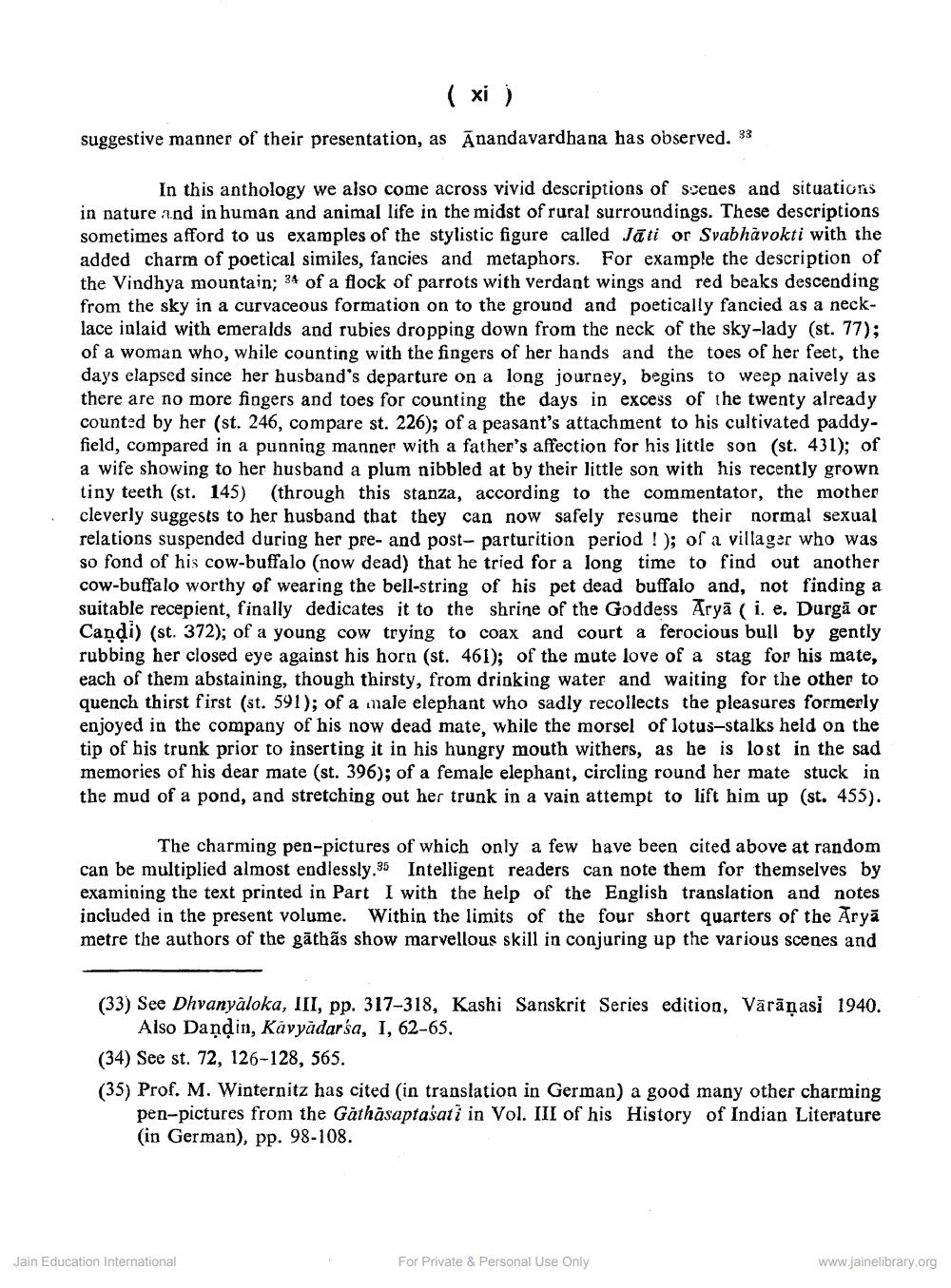________________
suggestive manner of their presentation, as Anandavardhana has observed. 33
In this anthology we also come across vivid descriptions of scenes and situations in nature and in human and animal life in the midst of rural surroundings. These descriptions sometimes afford to us examples of the stylistic figure called Jāti or Svabhāvokti with the added charm of poetical similes, fancies and metaphors. For example the description of the Vindhya mountain; 34 of a flock of parrots with verdant wings and red beaks descending from the sky in a curvaceous formation on to the ground and poetically fancied as a necklace inlaid with emeralds and rubies dropping down from the neck of the sky-lady (st. 77); of a woman who, while counting with the fingers of her hands and the toes of her feet, the days elapsed since her husband's departure on a long journey, begins to weep naively as there are no more fingers and toes for counting the days in excess of the twenty already counted by her (st. 246, compare st. 226); of a peasant's attachment to his cultivated paddyfield, compared in a punning manner with a father's affection for his little son (st. 431); of a wife showing to her husband a plum nibbled at by their little son with his recently grown tiny teeth (st. 145) (through this stanza, according to the commentator, the mother cleverly suggests to her husband that they can now safely resume their normal sexual relations suspended during her pre- and post-parturition period !); of a villager who was so fond of his cow-buffalo (now dead) that he tried for a long time to find out another cow-buffalo worthy of wearing the bell-string of his pet dead buffalo and, not finding a suitable recepient, finally dedicates it to the shrine of the Goddess Arya ( i. e. Durgā or Candi) (st. 372); of a young cow trying to coax and court a ferocious bull by gently rubbing her closed eye against his horn (st. 461); of the mute love of a stag for his mate, each of them abstaining, though thirsty, from drinking water and waiting for the other to quench thirst first (st. 591); of a male elephant who sadly recollects the pleasures formerly enjoyed in the company of his now dead mate, while the morsel of lotus-stalks held on the tip of his trunk prior to inserting it in his hungry mouth withers, as he is lost in the sad memories of his dear mate (st. 396); of a female elephant, circling round her mate stuck in the mud of a pond, and stretching out her trunk in a vain attempt to lift him up (st. 455).
The charming pen-pictures of which only a few have been cited above at random can be multiplied almost endlessly.35 Intelligent readers can note them for themselves by examining the text printed in Part I with the help of the English translation and notes included in the present volume. Within the limits of the four short quarters of the Aryā metre the authors of the gāthīs show marvellous skill in conjuring up the various scenes and
(33) See Dhvanyaloka, III, pp. 317-318, Kashi Sanskrit Series edition, Vārāṇasi 1940.
Also Dandin, Kavyādarśa, I, 62-65. (34) See st. 72, 126-128, 565. (35) Prof. M. Winternitz has cited in translation in German) a good many other charming
pen-pictures from the Gathāsaptaśati in Vol. III of his History of Indian Literature (in German), pp. 98-108.
Jain Education International
For Private & Personal Use Only
www.jainelibrary.org




